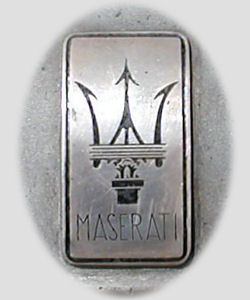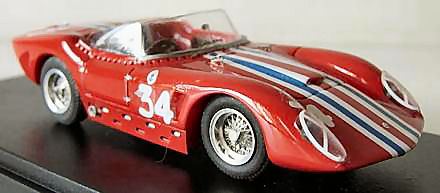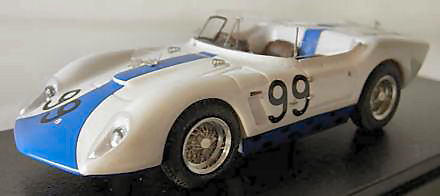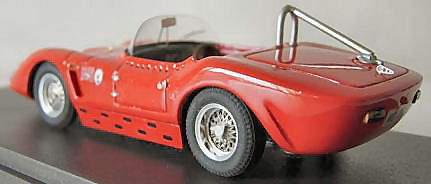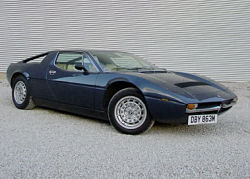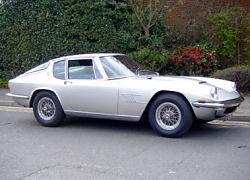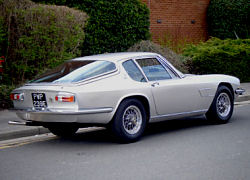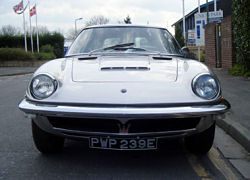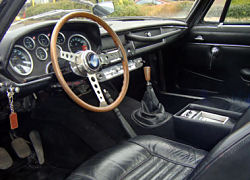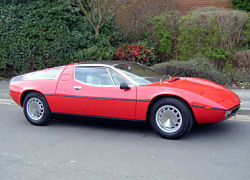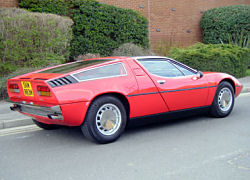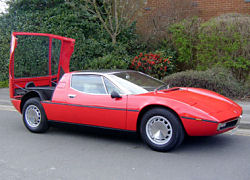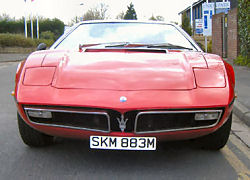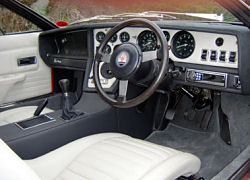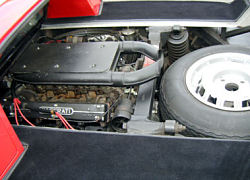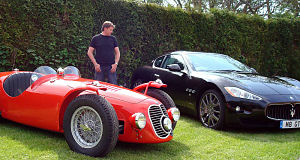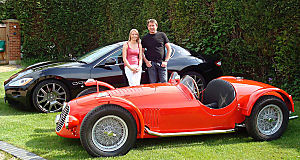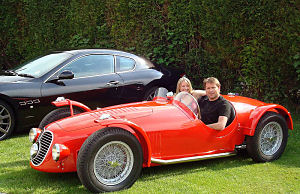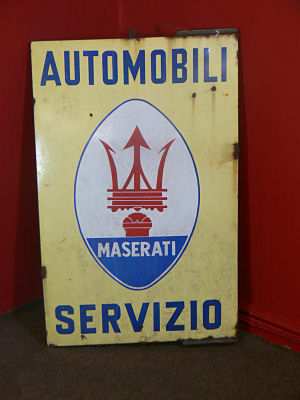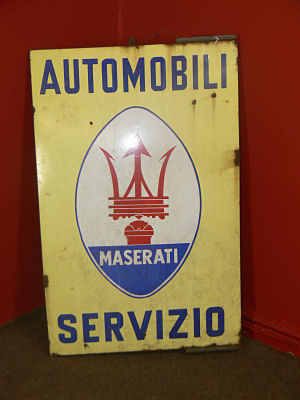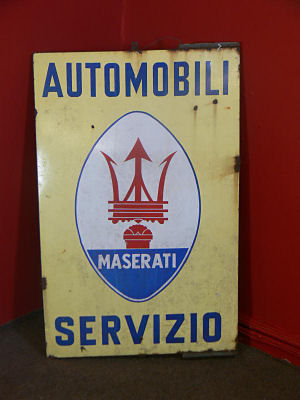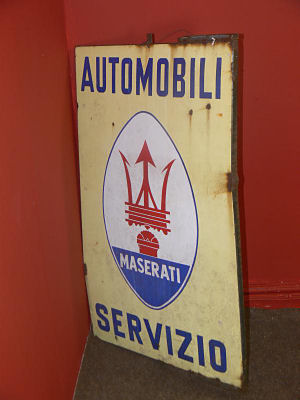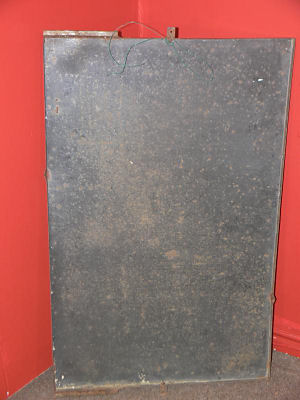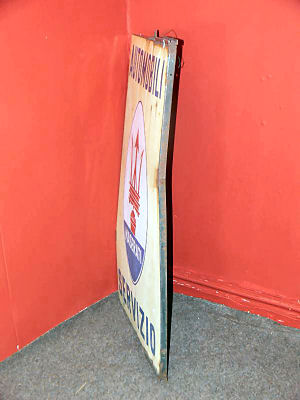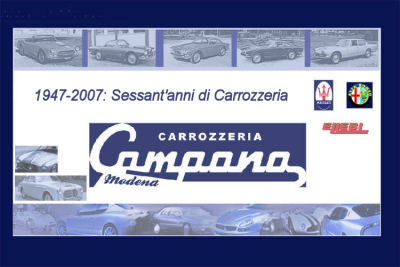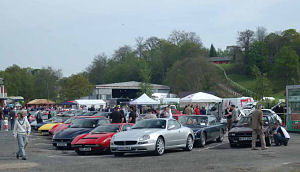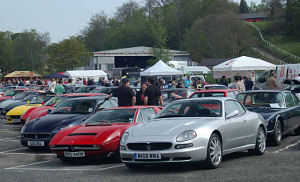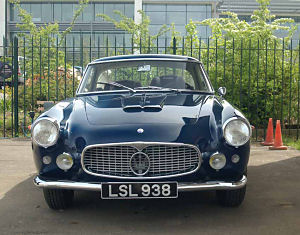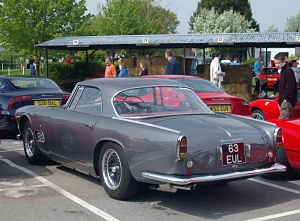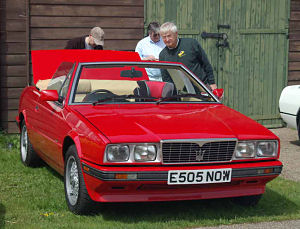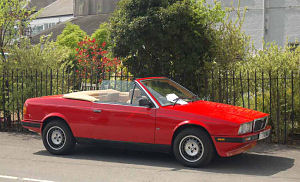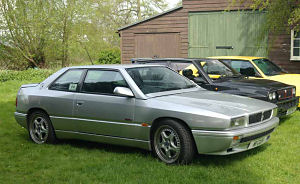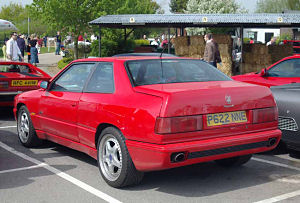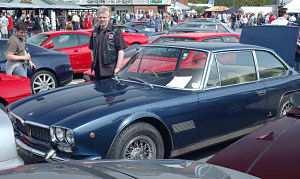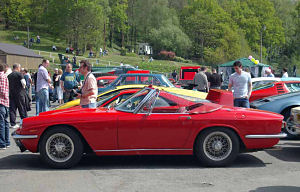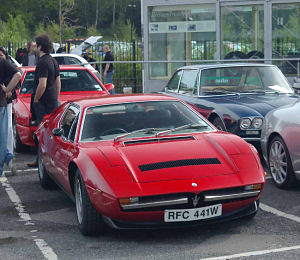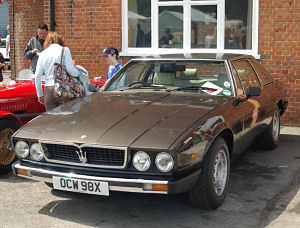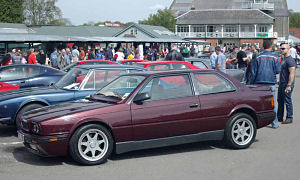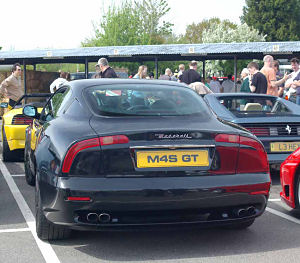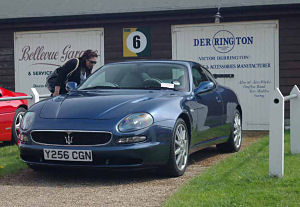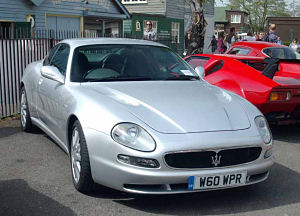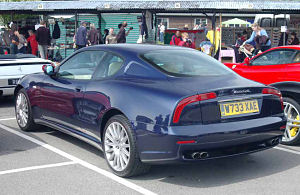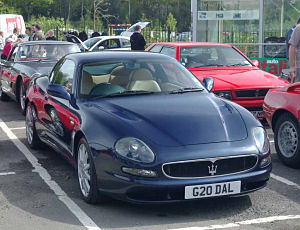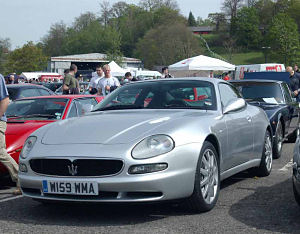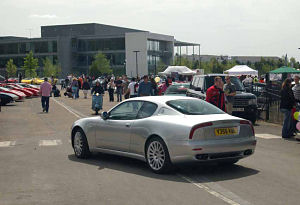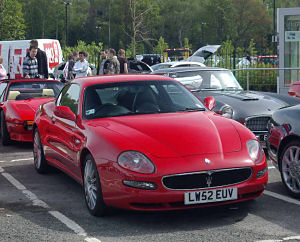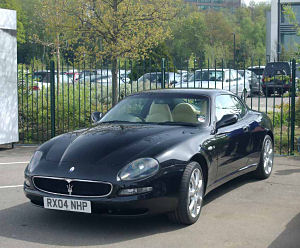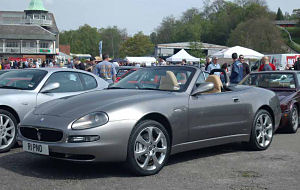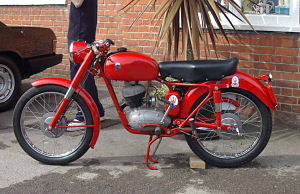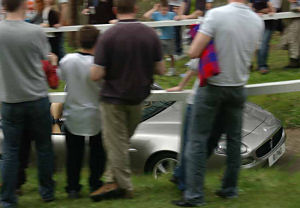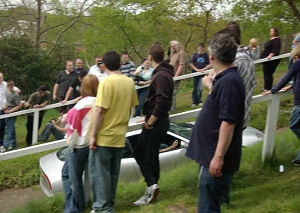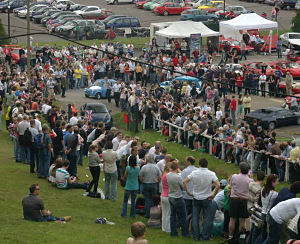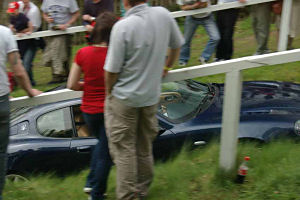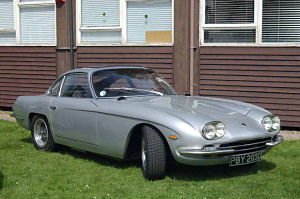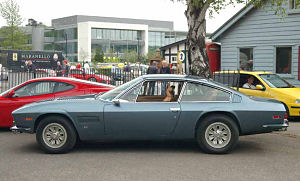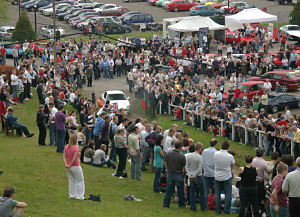| |
| |
 |
| |
| |
|
From Bonhams in Monaco |
| |
At the recent Bonhams sale "Les Grandes Marques à Monaco", held in Monaco on the 10th May 2008, the following Maserati related items and classic GTs went under the hammer. A 1966 Maserati Mistral 4000 Spyder sold for EURO 238,500 including buyer's premium and taxes and a 1982 Maserati Khamsin Coupé went for EURO 103,500 !!! |
| |
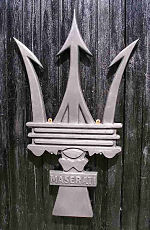 Lot 51 Lot 51
- Maserati Trident badge
A cold cast aluminium Maserati Trident badge, modern, 100 x 60cm.
Sold for €250 plus Premium and tax.

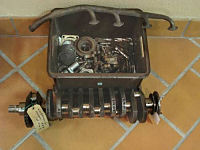 Lot 84a Lot 84a
- A Maserati 300S crankshaft
Estimate: €800-1,200
A Maserati 300S crankshaft, in good order and offered together with a quantity of spares for the car, including crown wheel, valve lifters, ball joints, suspension parts, head studs and others. (Qty.)
Sold for €900 plus Premium and tax.
|
| |
|
| |
Lot 126
- 1966 Maserati Mistral 4000 Spyder
Coachwork by Carrozzeria Frua
Chassis No: AM109/S1*641*
Sold for €210,000 plus Premium and tax
| 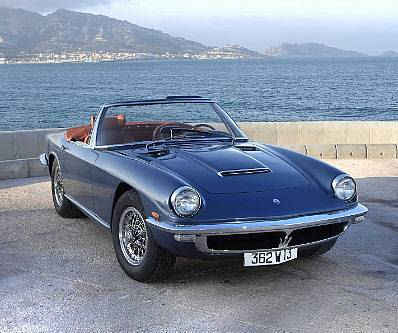
|
| |
Last of the classic six-cylinder Maseratis, the Pietro Frua-styled Mistral commenced production in 1963. The 3.7-litre version of the Modena manufacturer’s long-stroke engine was fitted to most cars,other options being the 3.5-litre or, from 1966, the 4.0-litre unit. A handsome two-seater on a shortened, square-tube chassis, the Mistral was built in coupé and spyder versions, the former's opening rear window hatch making it unusually practical for a sports car. A five-speed gearbox, disc brakes and fuel injection were standard equipment; automatic transmission, air conditioning and a limited-slip differential the options. Production ceased in 1970, by which time a total of 827 coupés and 123 spyders had been built.
This rare Mistral 4000 Spyder was manufactured in 1966 and imported into the USA where it was sold to its first owner, Mr F J Capretto of Seattle, in 1967. The car retains matching numbers on the engine block, cylinder head and chassis, and its history is known in full. In the early 1970s the Mistral was sold to the second owner, another Seattle resident, who drove it regularly until an overheating problem led to its being laid up in 1977. Thereafter the Maserati remained stored in a one-car garage in Seattle until exhumed in 2002.
In 2004 the car was purchased by its third owner, Mr Francis G (Frank) Mandarano, a noted Maserati historian, founder of the Maserati Club International and the successful, trend-setting Concorso Italiano, under whose expert direction its restoration was begun. Chassis number ‘641’ was delivered to Vancouver and entrusted to the well known Maserati specialist
Milo’s European Car for the mechanical rebuild which included everything from the radiator back to the fuel tanks. The engine was rebuilt using new liners, Asso pistons, bearings, valves, guides and seats, with all moving parts computer balanced to perfection. All hydraulics were rebuilt, including the clutch and brake master cylinders, brake boosters, calipers and new brake hoses. A new clutch was fitted, all hoses replaced and the fuel tanks and radiator cleaned. In addition, ‘641’ received a new set of reliable Weber 42 DCOE8 carburettors along with the original right-hand script cam cover. (The original Lucas fuel injection system comes with the car). A new stainless-steel exhaust was fitted from the manifolds back, and sounds wonderful. Over $35,000 was spent on the engine rebuild alone, with all expenses recorded.
The five original Borrani RW 3994 15” wire wheels were rebuilt and fitted with new Pirelli Cinturato tyres. Also included for winter driving is an extra set of (4) Starburst alloy wheels shod with excellent Michelins. The interior of ‘641’ received very special care. Firstly, the seats and door panels were re-trimmed in Turin, Italy by none other than Sig. Gavina, the man responsible for all the Quattroporte 3 interiors and the special four-door Ferraris and station wagons built for the Sultan of Brunei, as well as far too many great cars to list here. The exact colour match to the original leather was found in Italy, and four hides were purchased. World famous car trimmers, Luppi of Modena, supplied 16m2 of exactly matching Wilton wool carpeting, and back in Seattle the interior was finished by Steve Shepp, who also made a new convertible hood using the original as a pattern. In all, close to $15,000 was spent on trimming, including materials.
Circa 2005 the car came back to Europe where its restoration was completed by a specialist in the South of France. Presented in concours condition, the car is offered complete with its original hood covering and interior leather trim, together with a file of restoration photographs.
Images and Text are the sole copyright of Bonhams |
| |
|
| |
Lot 127
- 1967 Maserati Mistral 4000 Coupé
Coachwork by Carrozzeria Frua
Chassis No: AM109/A1*1248*
Estimate: €60,000 - 80,000
| 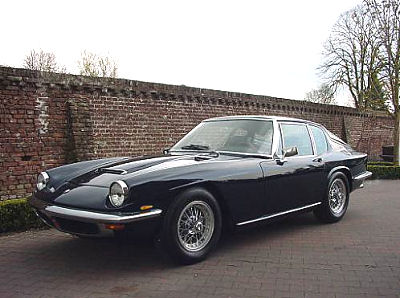
|
| |
Maserati’s survival strategy for the 1960s centred on establishing the company - which hitherto had mainly concentrated on its Grand Prix and sports car racing activities - as a producer of road cars. The Modena marque’s new era began in 1957 with the launch at the Geneva Salon of the Touring-bodied 3500GT. A luxury ‘2+2’, the 3500GT drew on Maserati’s competition experience, employing a tubular chassis frame and an engine derived from the 350S sports car unit of 1956. Suspension was independent at the front by wishbones and coil springs, while at the back there was a conventional live axle/semi-elliptic arrangement. Power output of the gorgeous twin-cam six was around 220bhp initially; later examples producing 235bhp on fuel injection.
The next development of the theme arrived in 1962. Built on the short-wheelbase chassis of the Vignale-bodied 3500GT spyder, the Sebring coupé featured a five-speed gearbox, disc brakes and fuel injection as standard equipment, with automatic transmission, air conditioning and a limited-slip differential available as options.
Last of the classic six-cylinder Maseratis, the Pietro Frua-styled Mistral commenced production in 1963. The 3.7-litre version of the famous long-stroke engine was fitted to most cars, other options being the 3.5-litre or, from 1966, the 4.0-litre unit, all of which came with Lucas fuel injection. With 255bhp available from its larger engine, an increase of 10bhp over the 3.7-litre unit, the Mistral 4000 was good for a top speed approaching 160mph (258km/h). A handsome two-seater on a shortened, square-tube chassis, the Mistral was built in coupé and spyder versions, the former’s opening rear window hatch making it unusually practical for a sports car. A five-speed gearbox, disc brakes and fuel injection were standard equipment; automatic transmission, air conditioning and a limited-slip differential the options. Production ceased in 1970, by which time a total of 827 coupés and 123 spyders had been built.
Retaining its original engine and gearbox, this Mistral was restored and mechanically rebuilt around 12-14 years ago and is presented in very nice overall condition. The car is finished in blue with original black leather interior and boasts the desirable wire wheels. One of Maserati’s best loved models in the most sought-after 4.0-litre specification, it is offered with Netherlands registration papers.
Images and Text are the sole copyright of Bonhams |
| |
|
| |
Lot 128
- 1976 Maserati Bora 4.7-litre Coupé
Chassis No: AM117*818*
Sold for €70,000 plus Premium and tax
| 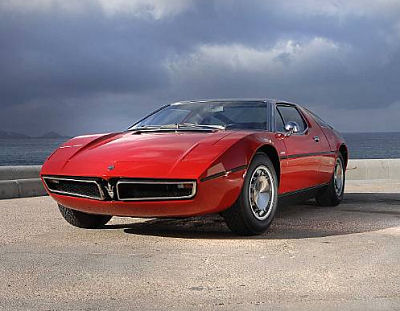
|
| |
The highlight of 1971 Geneva Salon was undoubtedly the sensational new Maserati Bora. With the Bora’s introduction, the great Modenese manufacturer followed other supercar constructors in going mid-engined, at the same time abandoning its traditional tubular chassis technology in favour of unitary construction. Named after a wind, the Bora was the work of Giorgetto Giugiaro’s Ital Design, at least as far as its bodyshell was concerned; the mid-mounted engine was Maserati’s familiar four-cam V8 in 4.7-litre form, the five-speed transaxle came from ZF and the all-independent double-wishbone suspension was penned by Giulio Alfieri, co-designer of the legendary 250F. One of the first ‘new generation’ models to appear following Maserati’s acquisition by Citroen, the Bora used the latter’s hydraulic technology to adjust seats and pedals, raise the headlamps and operate the excellent power-assisted brakes. A slippery shape plus 310bhp made for a very fast car - top speed was around 160mph (258km/h) - and the Bora had acceleration and handling to match.
By January 1976, Maserati’s management apparently had discussed shelving the Bora, but later that year decided to continue, though with a special enlarged 4.9-litre V8 engine for export to USA. Only some 25 Boras were made in all that year, and the total produced from 1971 to 1978 was only 571. The type was finally phased out in 1979. Motor magazine concluded its March 1973 road test thus: ‘The Bora impressed us as one of the best and most civilised mid-engined exotics we’ve tried, better developed than most of its ilk and immensely rewarding to drive, especially to drive fast on cross-country roads.’ What more could an enthusiast want?
The Bora was a stunning supercar by any standards, both then and now. This particular example is currently in the hands of only its third owner and has covered a mere 9,800 kilometres since a restoration in England. Finished in red with superb black interior, the car is offered with UK Swansea V5 document, German registration papers and file with many restoration bills. The Bora is an important and quite rare model, of which this is one of the most attractive example.
Images and Text are the sole copyright of Bonhams |
| |
|
| |
Lot 133
- 1981 Maserati Merak SS Coupé
Coachwork by Ital Design
Chassis No: AM122A*4090*
Engine No: AM122*77263*
Sold for €38,000 plus Premium and tax
| 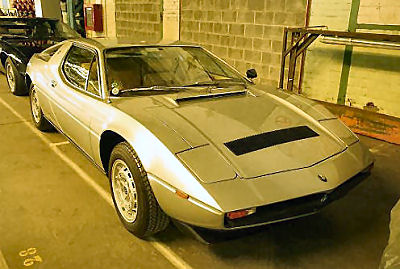
|
| |
Maserati followed-up its first mid-engined supercar - the Bora - with the similar Merak. Launched in 1972, the latter was intended as competition for Ferrari’s top-selling Dino 246 and used a stretched, 3-litre, 190bhp version of the four-cam V6 that had debuted in the Citroen SM. The French firm owned Maserati at the time, so the Merak made use of the SM’s transmission and power-operated, all-disc braking and, more controversially, Citroen’s quirky instrumentation, though this applied to lefthand-drive cars only, right-hand drive examples using the more conventional fascia of the Bora. The unitary-construction chassis, all-independent suspension and impeccable handling remained basically as the V8-engined Bora’s, though the Merak offered the convenience of ‘+2’ seating in the rear and superior all-round vision thanks to its distinctive rear ‘flying buttresses’.
Competition from Ferrari’s new Dino V8 prompted the introduction of a more powerful version - the Merak SS with 220bhp engine and revised interior - for 1975, ZF transmission being adopted shortly after. Widely recognised as one of the finest, if not the finest, of contemporary V6s, the Merak SS engine proved smooth, powerful and capable of delivering its urge over a surprisingly wide range for such a high performance engine. Like any true thoroughbred, the Merak possessed handling commensurate with its breathtaking acceleration and 150mph maximum speed. ‘Performance and handling are the raison d’etre of a mid-engined sportscar, and the Merak’s astounding cornering power is a match for its straight-line punch,’ observed Motor magazine.
Changes made to the SS suspension greatly improved ride comfort over that of the original Merak, while alterations to the instrumentation, switchgear, and interior, and the phasing out of the Citroen brakes in favour of a more conventional system addressed some of the criticisms levelled at the earlier version. The most successful Maserati of its day, the Merak ceased production in 1983 after 1,832 had been built, 626 of them the Merak SS.
Purchased new by the immediately preceding owner (the Swiss Maserati importer) and driven only by him, this Merak SS was delivered with an interior sumptuously trimmed to special order in leather, the material being applied to the transmission tunnel and door panels as well as the seats, and has covered just 10,787 kilometres from new. The car was bought by the vendor – only its 2nd owner from new – at Bonhams & Brooks’ auction of the Swiss Maserati Importer Collection at Les Grandes Marques à Monaco Sale in May 2001 (Lot 216) since when it has scarcely been driven. Given this limited use, a full mechanical check over is advised before returning it to the road.
Finished in Argento (silver), the car is equipped with electric windows and period radio/cassette, and comes complete with ‘space saver’ spare wheel. Not reregistered since acquisition in 2001, this exceptionally well-preserved ‘time warp’ Merak SS is offered with cancelled Swiss Permis de Circulation and is probably the finest example of its kind in existence.
Images and Text are the sole copyright of Bonhams |
| |
|
| |
Lot 143
- 1959 FIAT-OSCA 1500 Coupé
Coachwork by Carrozzeria Viotti
Chassis No: 118S002073
Estimate: €28,000 - 36,000
| 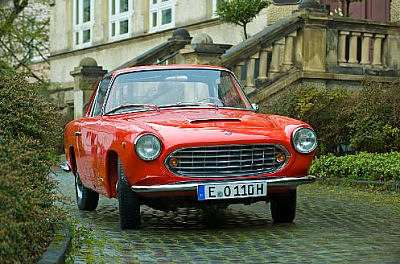
|
| |
OSCA’s outstanding success in international sports car racing led to its advanced twin-overhead-camshaft engine being taken up by FIAT, for whom it was ‘productionised’ by ex-Ferrari designer, Aurelio Lampredi. OSCA - Officine Specializzate per la Costruzione Automobili Fratelli Maserati - had been founded immediately after WW2 by the three surviving Maserati brothers, who had sold out to the Orsi Group in 1937. One of the reasons for the Maserati brothers’ departure was that they did not want to be involved in making road cars - they were racers pure and simple - and OSCA was set up to manufacture limited edition competition cars.
OSCAs performed magnificently in international sports car racing throughout the 1950s. In the 1954 Sebring 12-Hours, a round of the World Sports Car Championship, privately entered 1.5-litre OSCAs finished 1st, 4th and 5th against works teams in a category with no limit on engine capacity, an achievement as outstanding as it was unexpected. OSCAs took class wins in the Mille Miglia on ten occasions and also won the Index of Performance at Le Mans.
The first FIAT models to receive the OSCA-derived engine were the 1500 coupé and cabriolet, which were first introduced in 1959. Maximum power was reduced from 125bhp to 80bhp, but that still meant a top speed of 105mph and a 0-60mph time of 10.6 seconds. Dunlop disc brakes were standard from 1960. In 1962 FIAT introduced the milder, overhead-valve engined 1500 coupé/cabriolet but the authentic OSCA-powered original is the one to have.
The red FIAT-OSCA 1500 offered here wears fixed-head coupé coachwork by Carrozzeria Viotti. Founded in Turin in the early 1920s, Vittorino Viotti’s carrozzeria built bodies for (mainly) Alfa Romeo, Lancia and FIAT, mass-producing many special-bodied models for the latter. Famed designers such as Frua and Revelli worked for Viotti, producing many uniquely beautiful bespoke creations, and it is intriguing to speculate on who may have been responsible for this stylish FIAT-OSCA Coupé.
This actual car featured in Oldtimer Markt magazine’s November 1998 issue. Purchased by the current owner at Essen in 2007 and displayed at the Concours d’Elegance in Schloss Dyk in August of that same year, it is described as in wonderful condition throughout.
The car is offered with (copy) Oldtimer Markt article and German registration/roadworthiness papers.
Images and Text are the sole copyright of Bonhams |
| |
|
| |
Lot 150
- 1971 Maserati Ghibli SS Spyder
The property of Count Hubertus Von Dönhoff
Coachwork by Carrozzeria Ghia
Chassis No: AM115/S49*1265*
Estimate: €290,000 - 340,000
| 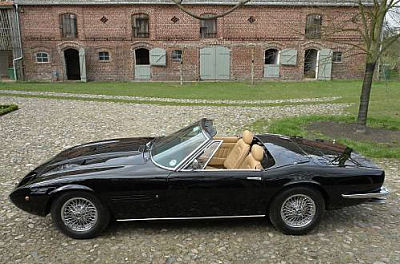
|
| |
For more than 30 years Count Dönhoff has campaigned his stable of historic Maserati cars – 150S, A6GCS, the ex-Prince Bira 250F Grand Prix monoposto - and for 25 years his famous 450S sports-racer - on the racetracks of Europe. After retiring from active racing the Count found this road-going Ghibli Spyder SS to be an ideal substitute for his 450S.
A strong contender for the ‘most handsome car of the 1960s’ title, Maserati’s sensational Ghibli debuted at the Turin Motor Show in November 1966. Styled at Carrozzeria Ghia by Giorgetto Giugiaro and named after a Sahara Desert wind, the Ghibli rivalled the Ferrari Daytona for straight-line performance - its top speed was close to 170mph (275km/h) - while beating it for price and - arguably - looks. More than 7 metres long and 2.8 metres wide, the Ghibli occupied an inordinate amount of space for a mere two-seater, but perhaps the most startling aspect of its appearance was the height, or rather the lack of it. Dry-sump lubrication enabled the engine to be mounted deep in the chassis, permitting a low bonnet line, while limited suspension travel ensured that the tyres did not foul the wheelarches. The roofline fell away from the top of the steeply raked windscreen to the chopped-off tail, Giugario thus achieving a cabin lower than that of almost all the Ghibli's contemporaries.
The Ghibli used a tubular steel chassis featuring independent suspension at the front, while at the rear there was a leaf-sprung, live rear axle with single locating arm. The power unit was Maserati’s venerable four-cam, 90-degree V8, an engine derived from that of the 450S sports-racer and first seen in road-going guise in the 5000GT. This was used in dry-sump, 4.7-litre form up to 1970 when it was superseded by the 4.9-litre ‘SS’ version. Power rose to 355bhp and performance was stunning, with 100mph (160km/h) attainable in under 16 seconds.
Even more sensational was the handsome Ghibli Spyder, launched in 1969 and the direct rival of the Ferrari Daytona Spyder. Giugiaro’s styling for an open-top Ghibli was arguably more successful than the original coupé and is regarded as a classic of sports car design.
Ghibli production ended in 1973 after 1,149 coupés and only 125 Spyders has been built. Of the latter, probably no more than 40 had the larger SS engine, and as most of these were destined for the USA it is safe to assume that only 20-or-so Spyders left the factory with both the larger engine and ZF five-speed manual gearbox, chassis number ‘1265’ – that is offered here - being one of these ultra-desirable rarities.
The car comes with various (copy) Maserati factory and Maserati Club build sheets indicating that it was despatched new to Grossman Motor Cars Corporation of Nyack, NY, USA on 1st September 1971 equipped with power steering and (Borrani) wire wheels. In January 2004 the Ghibli was acquired by its titled owner, who advises us that it is in good running condition. At time of acquisition the car had almost certainly covered fewer than 1,000 kilometres since its engine had been rebuilt by marque specialist Franco Tralli in Modena. Finished in black with beige leather interior, the car comes with comes with the aforementioned documentation and UK Swansea V5 document. A rare and well preserved example of Maserati’s answer to the Ferrari Daytona, offered in its ultimate specification.
Images and Text are the sole copyright of Bonhams |
| |
|
| |
Lot 180
- 1982 Maserati Khamsin Coupé
Coachwork by Carrozzeria Bertone
Chassis No: AM120*504*
Sold for €90,000 plus Premium and tax
| 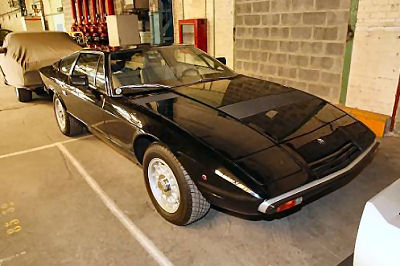
|
| |
Maserati’s final major introduction while under Citroen control, the Khamsin (named after a hot Sahara Desert wind) debuted at the 1972 Turin Show and entered production in 1974. Styled and built at Bertone, the attractive, unitary-construction, 2+2, hatchback body was all steel, and the front-engined Khamsin featured all-independent, double-wishbone suspension similar to that of the mid-engined Bora and Merak. Its state-of-the-art suspension and a 50/50 front/rear weight distribution combined to endow the Khamsin with near-perfect balance, and if its grip level was ultimately inferior to the Bora’s, then the Khamsin’s conventional layout made it easier to control on the limit.
Citroen’s hydraulic technology (as found in the Maserati-engined Citroen SM) was employed to power the brakes and steering - the latter, in particular, being rated as highly effective by testers - and also to raise the concealed headlamps. The power unit was a longer-stroke, 4.9-litre version of Maserati's familiar quad-cam V8 developing 320bhp at a lowly 5,500rpm and a lusty 354lb/ft of torque at 4,000 revs. A five-speed ZF manual gearbox or three-speed Borg-Warner automatic transmission were options, and when equipped with the former the Khamsin was good for around 240km/h (150mph). Only 430 examples of this most exclusive and consummate Grand Routier had been made when production ceased in 1982.
Although seemingly less extravagant than the mid-engined Bora supercar, the Khamsin was Maserati's biggest-engined and most expensive offering at the time of its introduction, and thus could justifiably claim to be its top-of-the-range model. By virtue of its front-engined layout, the Khamsin offered greater practicality, providing a roomier and more comfortable interior and superior luggage carrying capacity.
Dating from the final year of production, this is the 3rd last Khamsin built and was delivered new in Geneva to His Highness Sheikh Hammad Al Thani, the car collecting member of the Quataar royal family. Shortly afterwards the car was purchased directly from its first owner by the immediately preceding owner, who kept it in climate controlled storage. The Khamsin was bought by the vendor – only its 3rd owner from new – at Bonhams & Brooks’ auction of the Swiss Maserati Importer Collection at Les Grandes Marques à Monaco Sale in May 2001 (Lot 219).
Finished in the Sheik’s favoured colour combination of black with cream leather interior, and boasting Campagnolo wheels shod with Pirelli P600 tyres, the car has covered only 95 kilometres since then and an amazing 1,299 kilometres in total from new. Presented in ‘time warp’ condition throughout, this surely is the finest ‘as delivered’ example of the model left in existence and as such almost certainly unique. Given its limited use, a full mechanical check over is advised before returning the Khamsin to the road. The car has not been reregistered since acquisition in 2001 and comes with Swiss import paperwork (Form 1320A).
Images and Text are the sole copyright of Bonhams |
| |


